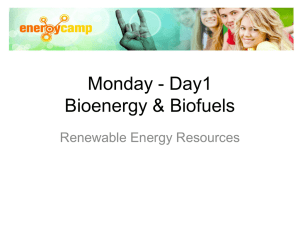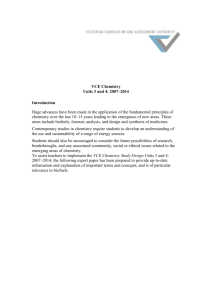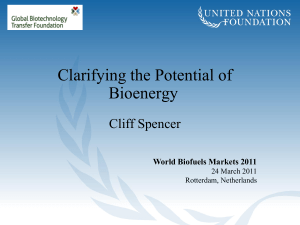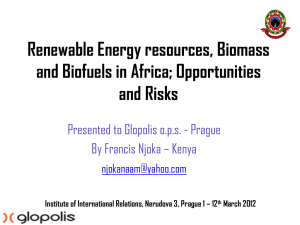Bioenergy Platforms and Technologies
advertisement
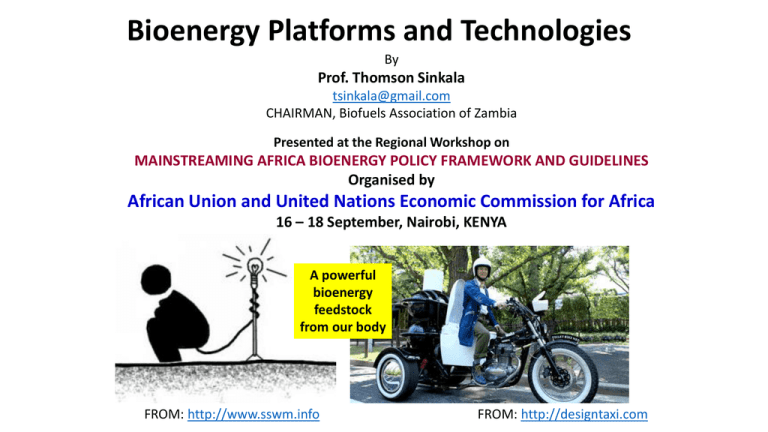
Bioenergy Platforms and Technologies By Prof. Thomson Sinkala tsinkala@gmail.com CHAIRMAN, Biofuels Association of Zambia Presented at the Regional Workshop on MAINSTREAMING AFRICA BIOENERGY POLICY FRAMEWORK AND GUIDELINES Organised by African Union and United Nations Economic Commission for Africa 16 – 18 September, Nairobi, KENYA A powerful bioenergy feedstock from our body FROM: http://www.sswm.info FROM: http://designtaxi.com CONTENTS • Bioenergy production technologies • Research, development, demonstration and deployment • Institutional and technical capacity development • Conclusions BIOENERGY PRODUCTION TECHNOLOGIES 3 GENERAL ORGANISATION OF TECHNOLOGIES • • • • • • • • Fuel wood Charcoal Agricultural waste Wood pellets Biogas Bioethanol (equivalent of gasoline) Biodiesel (equivalent of diesel), and Bioelectricity Examples of Firewood Production Technologies and Use Easy to harvest Strenuous to harvest Easy to transport A lot in store, few trips A burden to carry Little in store, many trips Clean cooking stove Unhealthy cooking Examples of Charcoal Fuel Technologies and Use Example of Agricultural Waste for Cooking Litter Drying Heaping Cooking Examples of Wood Pellet Processing Economics between charcoal and wood pellets Cost structure of charcoal Blantyre and Lilongwe FROM: Kambewa P. etal. 2007. Charcoal: the reality - A study of charcoal consumption, trade and production in Malawi. pubs.iied.org/pubs/pdfs/13544IIED.pdf. Energy efficiency of selected cooking fuels Based on the Malawi study, charcoal costs 6.0 to 10 US$/40 Kg bag (Malawi), or US$2,700/Ha for 15 tons of wood cleared. Pellets from wood shavings cost about 3.0 to 5 US$/40 Kg bag (Zambia, personal communications with Dr. Per Lofberg of Vagga till Vagga AB of Sweden) Example of Biogas Production (FROM: http://www.google.co.zm/imgres?imgurl=) Agro/Bioenergy Production Synergies (FROM: biogas.ifas.ufl.edu) Electricity Production from Biogas (FROM: http://www.google.co.zm/imgres?imgurl=) Biogas Market Biogas cookstove Biogas generator (Alibaba) Biogas fridge Biogas car (oneighturbo.com) BIOGAS (One Stop Gas) Biogas train Biogas lamp Biogas truck (www.metaefficient.com) Biogas bus (Sweden) Biogas motorbike (www.inforse.org) 13 Examples of Bioethanol Feedstocks + Grass and Wood Bioethanol Feedstock Characteristics (Costs are for Zambia) ITEM Feedstock unit cost Yield, (Metric Tons/Ha) Yield, (Litres/Metric Ton), fresh roots. Yield, (Litres/Ha/Harvest) Water Requirement, (mm/crop) Fertiliser Requirement, (Kg/Ha) Gestation Period, (months) SUGARCANE SWEET SORGHUM CASSAVA AGAVE Americana SUGAR BEET 0.381 110 0.384 20 - 100 0.15 – 0.47 12 - 40 0.512 80 80 45 170 125 0.15 to 0.29 60 to 80 110 8,800 900 – 4,500 2,000 - 6,000 3,600 - 12,000 1500 - 2500 450 to 700 N 75-150 P 30-60, K 60-120. 4 – 4.3 400 - 750 500 NPK N20:P10:K10, 9 (50 kg) bags (if necessary) 150 – 350 Kg Urea (if necessary) 12 - 16 60 - 72 300 basal & 250 kg urea 12 - 14 Maize, sorghum, vegetables, legumes, rubber, oil palm, tropical sugarbeet (Gokhale, 2010). Rotation Crops Examples of Immediate Revenue Diversification Remarks Food, Feed, Fiber, Food, Feed, Fiber, Biogas, Electricity, Biogas, Electricity, Fertilizer Fertilizer Can be stored as molasses. Food, Feeds, Fiber, Biogas, Starch, Electricity, 4,800 – 10,000 600 5-6 Corn, sorghum, vegetables, cassava (Gokhale, 2010) Food, Feed, Fiber, Biogas, Electricity, Fertilizer Harvested and Extensive experience 10,000 – 15,000 plants per hectare, processed s within in Mexico, but also 80cm – 100cm spacing and rows. Can a month. Stored as Australia and USA be processed from fresh roots or dry. molasses. recently. Biogas, Electricity Must process fresh roots Bioethanol, bioelectricity and fertiliser (FROM: http://www.sseassociation.org/Publications/feasibilitystudyofsweetsorghum.pdf) Modular Biorefineries and their Importance • • • • • Can be commissioned within 5 - 8 months. No need for large start-up capital. Can process multiple feedstocks. Minimum 500,000 L/year (1,670 L/day) bioethanol. Minimum 360,000 L/year (1,000 L/day) biodiesel. E.g. Mansego Modular Bioethanol Refinery Fermentation module Distillation module Dehydration module Liquefaction module 17 Bioethanol Market Flexi fuel generator Bioethanol cookstove Bioethanol fridge Flexi fuel car Eg. BIOETHANOL A One-Stop Fuel Flexi fuel plane Bioethanol lantern Bioethanol truck Bioethanol bus Flexi fuel motorbike 18 Examples of Biodiesel Feedstocks + Animal Fat, Waste Cooking Oil, Algae and Wood Biodiesel Feedstock Characteristics (Costs are for Zambia) ITEM Feedstock unit cost, US$/Litre Yield, (Metric Tons /Ha) Yield, (Litres/Metric Ton) Yield, (Litres/Ha) Water Requirement, mm Fertilizers Requirement, (Per Ha) Gestation Period, (months) SOY PALM JATROPHA MORINGA CASTOR SUN FLOWER 0.429 3.5 196 686 0.426 15.8 230 4,803 3 – 5mm per day during hot-dry season 0.459 6.0 300 1,800 0.290 3.0 400 1,200 0.562 1.0 489 489 0.698 2.0 398 796 500 - 600 250 – 3000 500-600 600 -1000 450 - 700 250 Basal, 100 Urea N170-230, P70-90, K220310 per Year 4.5 to 5 24 – 30 Examples of Immediate Revenue Diversification Food, Feed Food, Electricity, Fodder, Building, Furniture Remarks Currently experiencing high prices in the food market. When efficient, ONE worker can harvest 10hectare (Fact Foundation, 2010) 2.5 t Manure 24 - 36 Feed, Biogas, Electricity, Fertilizer There is presently no “Cook Book” to give definite yields. Yields are currently location specific. Appropriate amount of manure, when and N40,P40, K20 if necessary 12 - 24 4-6 Food, Feed, Biogas, Fertilizer, Electricity, Fertilizer, Biogas Etc A very important oil Among the world’s in high-tech most useful plants. industry as a lubricant. 200 Basal, 150 Urea. 4.2 to 4.5 Food, Biogas Feed, Biodiesel Processing Biomass for Electricity Generation in Biodiesel Processing (SOURCE: http://3.bp.blogspot.com/_bCNdcYdqloQ/S9jg4-iNsFI/AAAAAAAAAMA/E7jJT3RVEfQ/s1600/palmtree-biomass.jpg) Electricity Generation from Biomass (SOURCE: http://www.mpoweruk.com/biofuels.htm) Range in recent levelized cost of energy for selected commercially available renewable-energy technologies FROM: www.unep.org/greeneconomy 24 RESEARCH, DEVELOPMENT, DEMONSTRATION AND DEPLOYMENT 25 Bioenergy Value Chain 1. PRELIMINARY ACTIVITIES 2. PRODUCTION INFRASTRUCTURE 3. FEEDSTOCK PRODUCTION and TRADE 4. BIOFUELS PROCESSING 5. BIOFUELS TECHNICAL SERVICE ACTIVITIES Business Plans Sourcing funds Land acquisitions / lease contracts Impact assessments Obtaining permits and licences Securing markets Setting-up of bioenergy industry governance Technology assessments Etc Drilling boreholes Building dams and canals Assessing soils Building access roads and bridges Building houses and offices Building processing plants Etc,. Land clearance Land preparations Nurseries Plantation development Plantation management Weed and pest control Feedstock harvesting Feedstock trading Etc. Cassava peeling, chipping and drying Seed cleaning and packaging Oil extraction Molasses production Processing and refining of biofuels Byproducts production. Biofuels transportation Byproduct transportation Biofuels blending Biofuels transportation Engine conversion Importation of biofuels compliant vehicles and appliances Manufacturing of inputs and processing plants for the biofuels value chain Biofuels R&D Training in biofuels industry Biofuels quality control assessments Biofuels plant repair Development of appropriate cookstoves Etc. OTHER SERVICES Education Health Recreation Etc Activities include identifying and addressing the challenges for sustainable bioenergy production through good industry governance, field trials, applied research, capacity building, modeling and 26 analysis. Feedstock for Wood, Charcoal and Pellets EXAMPLES OF RESEARCH AREAS • • • • Fast-growing and water-efficient forest plants Sustainable wood harvest Efficient/cost-effective forest management Incorruptible forestry governance and licensing Cookstoves (FROM: http://apps1.eere.energy.gov) General Research, Development, Demonstration and Deployment FEEDSTOCK SUPPLY Identify sustainable, highquality feedstock supply and quantify risk Baseline sustainable regional feedstock productivity Develop commercial-scale supply systems CONVERSION Reduce costs/improve quality of intermediates Reduce enzyme costs Develop fermentation organisms Enable high performance separations technologies Improve catalyst performance– cleanup/ conditioning and fuel synthesis Maximize carbon utilization Optimize reactor performance DEMONSTRATION & DEPLOYMENT Validate biorefinery operations Establish pioneer plants Support advanced biofuels compatibility testing Support biopower demonstration and deployment Cross-cutting areas SUSTAINABILITY Assess effects across full supply chain Establish baselines and targets for improving sustainability Develop best practices STRATEGIC ANALYSIS Define and validate technology performance targets Guide program planning Assess progress STRATEGIC COMMUNICATIONS Increase awareness of accomplishments Communicate new technology strategies Educate stakeholders on environmental and oil-displacement benefits (FROM: http://apps1.eere.energy.gov) Feedstock Supply and Logistics Feedstock constitutes about 70% of final bioenergy product. Providing biomass for conversion into biofuels represents an economic opportunity for communities across Africa. This requires developing the technologies and systems needed to sustainably and economically deliver a broad range of biomass in formats that enable efficient use in biorefineries. Feedstock Supply and Logistics (continued) The diverse biomass transformed by these technologies and systems must be consistent, quality-controlled commodity products that can be efficiently handled, stored, and transported to biorefineries for processing. This work requires a complementary focus on feedstock supply interfaces and logistics, as follows (http://apps1.eere.energy.gov). • Interfaces: To develop compatibility at interfaces with commercial-scale handling equipment and conversion processes, R&D should explore biomass specifications and characteristics, the effects of various handling techniques, and the resulting impacts on conversion performance. • Logistics: R&D is required for systems for harvesting, collecting, preprocessing, storing, and transporting diverse forms of biomass more efficiently. Therefore it is important to also research and develop equipment and systems to improve biomass quality, reduce costs, and increase productivity. INSTITUTIONAL AND TECHNICAL CAPACITY DEVELOPMENT 32 INSTITUTIONAL AND TECHNICAL CAPACITY DEVELOPMENT Government Policies, regulations and standards Governance Information on value for investment (e.g. balance sheet approach) Etc Industry Feedstocks Technologies Production efficiencies Etc Public / consumers Consumer information Value chain information Products Standards Etc Universities / Educational Institutions Mainstreaming bioenergy in curricula Research, development and demonstration Etc NGOs Community needs and information Bioenergy industry participatory methods Community resource management Land rights Gender issues Etc RECs Identifying and providing info on best practices in bioenergy development Capacity building in cross-border bioenergy issues Etc CONCLUSIONS 36 Africa has resources (material and human), but lacks productive action. Available technologies can be used to establish a vibrant bioenergy industry in Africa. Bioenergy is (probably) the only industry that can benefit all on sustainable basis. Economic empowerment from bioenergy industry, if well organised, can reduce conflicts and save the environment. 37 Thank you for your attention



